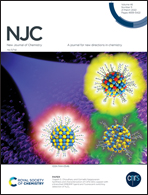Efficient photocatalytic degradation of tetracycline by Z-scheme CuSnO3/g-C3N4 heterojunctions coupling with H2O2 under visible light irradiation
Abstract
A series of Z-scheme CuSnO3/g-C3N4 heterojunctions were synthesized by a precipitation–calcination method. Morphological features, chemical composition, optical properties and crystallographic information of the prepared materials were obtained using scanning electron microscopy (SEM), transmission electron microscopy (TEM), powder X-ray diffraction (XRD), Fourier transform infrared spectroscopy (FT-IR), UV–Vis diffuse reflection spectroscopy (UV-Vis DRS), and photoluminescence spectroscopy (PL). The as-fabricated catalysts assisted by H2O2 showed remarkably enhanced photocatalytic performance for the degradation of tetracycline (TC) under visible light irradiation. The 20 wt% CuSnO3/g-C3N4 composite exhibited the highest photocatalytic degradation activity, which could be up to 93.6% at 60 min for the degradation of TC under visible light irradiation. Reactive species scavenging experiments revealed that superoxide radicals were the main active species during the photocatalytic process. This work will be useful for the design of other direct Z-scheme photocatalytic systems for applications in energy conversion and environmental remediation.



 Please wait while we load your content...
Please wait while we load your content...